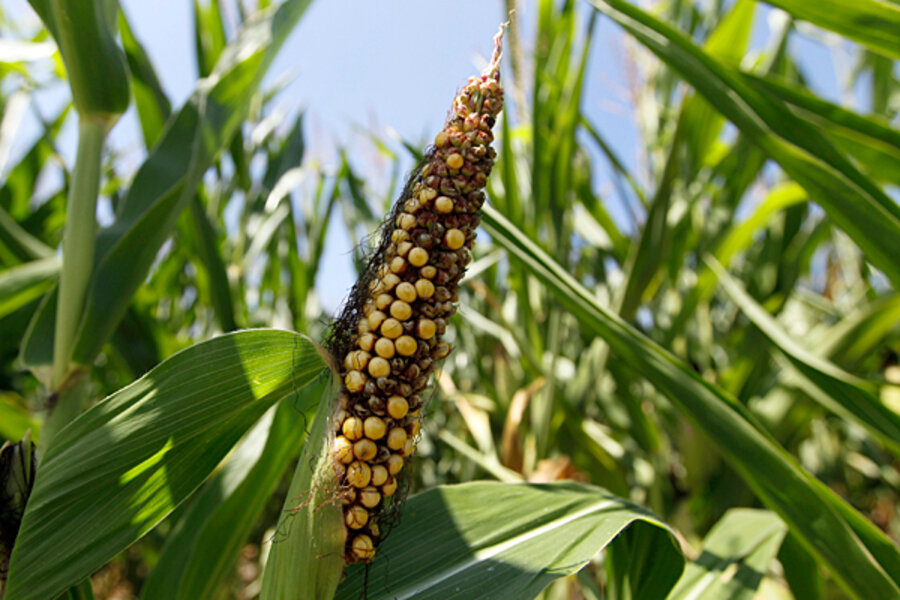Alarms sound over world food supply as drought wilts US Corn Belt
Loading...
| Atlanta
A historic Midwest drought prompted the US government on Friday to slash supply estimates for nearly everything in the US cornucopia, including corn, soybeans, and sorghum – a move that caused commodity prices to jump and concerns about the state of the global food cupboard to rise.
US corn and soybeans are crucial to global food supply because they are used for food, feed, cooking oil, and even motor fuel. Reduced supply and higher prices mean that poorer, import-reliant nations may not be able to replenish their food stocks.
"This is shocking,” Dan Basse, president of Ag Resources, said during a conference call on Thursday, ahead of the World Agricultural Supply and Demand Estimates report from the US Department of Agriculture. “This is getting people at the United Nations very concerned. The poor in the world are going to see tremendous pressure on their budgetary expenditure for calories. This has become a very scary situation, particularly for those in the world who are impoverished."
With the release of the global supply and demand report Friday morning, prices on the commodities exchange in Chicago rose to all-time highs for corn and soybeans, the hardest-hit crops so far. The estimate for the US corn crop is at the lowest level since 1995-96, when many fewer acres were planted.
The report piggy-backed on the release Thursday of the United Nations Food and Agriculture Organization’s Food Price Index, which showed global food prices rising by 6 percent, largely because of the US drought. Untimely rains in sugar-producing Brazil and dry conditions in Russia's wheat belt, too, have taken a toll.
The hottest July on record in the Lower 48 and scant rainfall have created the widest US drought since 1956, wiping out much of the corn and soybean crops, which are used globally and domestically for food, feed, and ethanol production. In the US, which is the world’s top exporter of corn, more than half the crop is now considered in “poor” condition. The Agriculture Department on Friday slashed yield estimates by 12 percent, from 146 bushels per acre to 123 bushels per acre.
American farmers had planted the largest corn crop ever this year, in response to high commodity prices and high global demand. The US was supposed to be “swimming” in corn this fall. Instead, the harvest will be a “train wreck,” Kelly Wiesbrock, a fund manager for Harvest Capital Strategies, tells the Reuters news service.
Higher commodity prices mean poorer countries will import much less, putting millions of people on the lower rungs of the global food chain in jeopardy, and potentially creating a situation similar to the world food crisis of 2007-08. In all, estimates for this year's global grain supply are down by 180 million metric tons – enough to fill about 360 supertankers to the brim.
"This is not some gentle monthly wake-up call,” Oxfam spokesman Colin Roche told the press after the latest figures were released. “It's the same global alarm that's been screaming at us since 2008. These new figures prove that the world's food system cannot cope on crumbling foundations. The combination of rising prices and expected low reserves means the world is facing a double danger."
A May report from the National Intelligence Council, an adviser to the federal government, suggested that countries that depend on food imports – Pakistan, Bangladesh, Sudan, South Sudan, and Egypt, to name a few – are vulnerable to social unrest should food prices rise too high.
In the previous world food shortage, some 60 food riots erupted across the globe, the US State Department has reported.
The drought is serving to highlight the importance, and vulnerability, of the US Corn Belt as it relates to global food supply. More specifically, the situation has focused new criticism on US ethanol production mandates, which require that 40 percent of an already-poor crop go toward refining the coarse grain into car fuel. The mandates were put in place over the past decade to help cut greenhouse-gas emissions and to make the US more energy-independent. So far, President Obama has said he’s not considering waiving the mandate.
“An immediate, temporary suspension of that [ethanol] mandate would give some respite to the market and allow more of the crop to be channeled toward food and feed uses,” José Graziano da Silva, director general of the UN’s Food and Agriculture Organization (FAO), wrote recently in the London Financial Times.
Government economists expect corn prices to rise to a record $9 a bushel, up from a $6 bushel estimate in early July. But private ag economists suggest that the drought is worse than advertised and that prices could go even higher.
Extrapolating from price peaks set in 1973, a year when corn and soybean supply was about as tight as it is today, and adding current demands, Terry Roggensack of the Hightower Report concluded that corn prices could go as high as $17 a bushel and soybean prices could top $50 a bushel.
Such prices could make some farmers and commodity traders wealthy, but they could be devastating for poorer, food-importing nations. “The U.S. leads the world in exporting corn, soybeans and wheat, and the surging prices are expected to be felt across the international marketplace, hurting poor food-importing countries,” said a study by British charity Oxfam issued ahead of this week’s UN report.
However, the FAO did note that its overall food price index for July remains well below the peak reached in February 2011, suggesting that countervailing forces – including lower beef prices – may yet stave off a repeat of the 2007-08 global food shortage.







